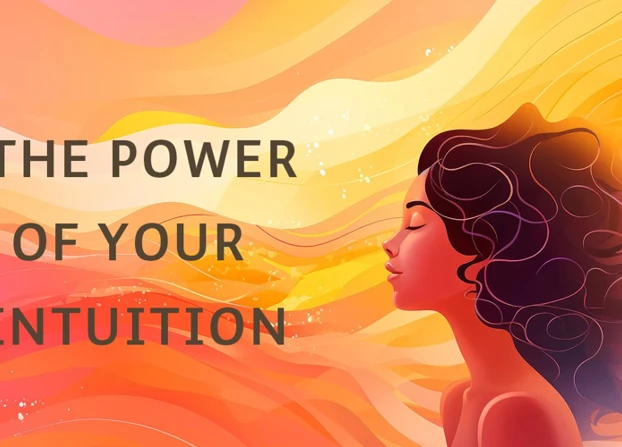At times, we find ourselves grappling with indecisiveness and uncertainty. In such moments, tapping into our intuition can serve as a guiding force. Meditation is a powerful practice that can greatly aid in the development of this innate ability. By cultivating self-awareness, enhancing intuitive abilities, and improving focus and concentration, meditation becomes a key tool for honing our intuition. In this article, we will explore the profound connection between meditation and intuition, as well as provide step-by-step guidance on how to incorporate meditation into your daily routine to unlock your intuitive potential. So, let us embark on this transformative journey of self-discovery and tap into the power of meditation for developing intuition.
Contents
- What is Intuition?
- The Importance of Developing Intuition in Tarot Reading
- Benefits of Meditation for Intuition
- How to Meditate for Intuition Development
- Specific Meditation Techniques for Intuition
- Other Practices to Enhance Intuition
- Incorporating Meditation into Tarot Reading
- Troubleshooting Common Challenges
- Conclusion
-
Frequently Asked Questions
- 1. Can anyone develop their intuition through meditation?
- 2. How long does it take to see results in intuition development through meditation?
- 3. Can meditation help with making better decisions?
- 4. Is it necessary to have prior experience with meditation to develop intuition?
- 5. Can meditation help me trust my intuition more?
- 6. Are there any specific meditation techniques that are more effective for intuition development?
- 7. Can journaling support intuition development alongside meditation?
- 8. Is tarot meditation an effective practice for honing intuition?
- 9. Can mindfulness during tarot reading enhance intuition?
- 10. Can meditation help overcome blocks and challenges in intuition development?
- References
What is Intuition?
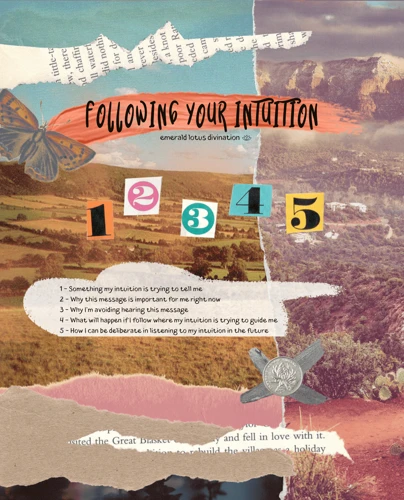
Intuition is often described as a deep inner knowing or a gut feeling that goes beyond logical reasoning. It is an instinctive understanding or perception that arises without conscious thought or analysis. Intuition can guide us in making decisions, providing insights, and accessing information beyond what our five senses can perceive. It is believed to be a form of intelligence that taps into our subconscious mind, allowing us to access wisdom and knowledge that is not readily available through conventional thinking. Intuition can manifest in various ways, such as a subtle inner voice, a feeling in the body, or a vivid image or symbol. By honing our intuition, we can tap into a valuable source of guidance and wisdom that can greatly enhance our daily lives. It is worth noting that intuition can be developed and strengthened through various practices, such as meditation, journaling, and tarot reading. These practices offer unique opportunities for self-reflection, introspection, and connecting with our intuitive senses. /exploring-five-senses-enhance-intuition/
The Importance of Developing Intuition in Tarot Reading
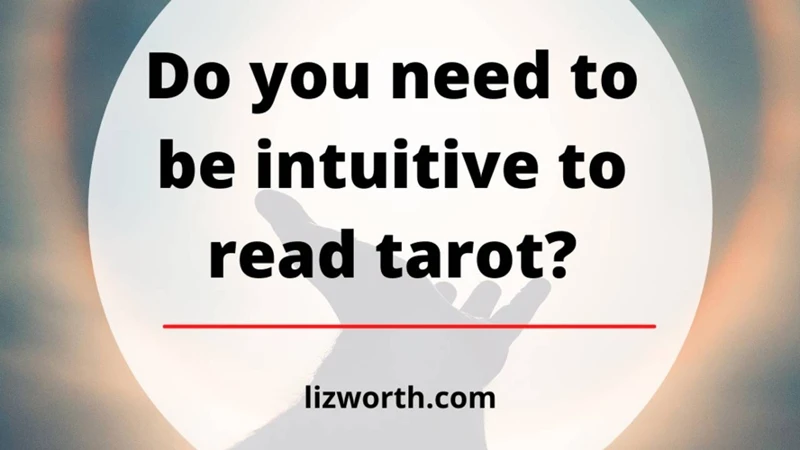
Developing intuition is of utmost importance in the practice of Tarot reading. While Tarot cards provide a structured framework for interpretation, it is the intuitive insights that bring the readings to life and provide deeper meaning. Intuition allows the reader to go beyond the surface-level symbolism of the cards and tap into the inherent wisdom and messages they hold. By developing intuition, Tarot readers can access their inner guidance and make intuitive connections between the cards, creating a more nuanced and accurate reading. Intuition helps interpret the cards in a way that resonates with the querent’s unique circumstances and provides valuable insights into their past, present, and future. It allows the reader to trust their instincts and delve deeper into the hidden layers of symbolism and meaning within the Tarot deck. By combining intuition with the knowledge and understanding of the Tarot, readers can offer profound and transformative readings that truly connect with the querent’s emotional and spiritual journey. To enhance intuition in Tarot reading, it is beneficial to engage in practices such as journaling and reflective writing /enhancing-intuition-journaling-reflective-writing/ to develop self-awareness and strengthen the intuitive abilities required to interpret the Tarot cards effectively.
Benefits of Meditation for Intuition

Meditation acts as a catalyst for developing and harnessing our intuitive abilities. By regularly practicing meditation, we can experience a multitude of benefits that foster the growth of our intuition. Firstly, meditation deepens our self-awareness by quieting the mind and allowing us to become more attuned to our thoughts, emotions, and inner sensations. This enhanced self-awareness creates an optimal environment for our intuitive senses to flourish. Additionally, meditation enhances our intuitive abilities by sharpening our focus and expanding our consciousness. As we cultivate a state of present-moment awareness during meditation, we become more receptive to subtle signals and insights from our intuitive intelligence. Meditation improves our overall level of focus and concentration, which are essential for honing our intuitive skills. By training our minds to remain focused, we can better tune into our intuition and discern its wisdom. To reap these benefits, it is important to make meditation a regular part of our daily routine, allowing us to fully tap into our intuitive potential and gain valuable insights and guidance along our journey of self-discovery. /tarot-intuition/
1. Deepening Self-Awareness
Deepening self-awareness is a fundamental step in developing intuition through meditation. Self-awareness involves consciously observing our thoughts, emotions, and sensations without judgment or attachment. By practicing self-awareness, we can gain a deeper understanding of ourselves, our patterns of thinking, and our reactions to different situations. During meditation, we can cultivate self-awareness by focusing on our breath or bodily sensations and observing our thoughts as they arise and pass away. This introspective practice allows us to become aware of any mental or emotional blocks that may be hindering our intuitive abilities. By acknowledging and letting go of these blocks, we create space for our intuition to blossom. Additionally, deepening self-awareness helps us differentiate between the voice of our intuition and the voice of our ego or conditioning. As we become more attuned to our authentic selves, we can discern between intuitive insights and rational thoughts, allowing us to make decisions that align with our inner wisdom. Using /enhancing-intuition-journaling-reflective-writing/ in conjunction with meditation can also be beneficial as it offers a platform for self-reflection and understanding.
2. Enhancing Intuitive Abilities
Enhancing intuitive abilities is a crucial aspect of developing intuition. Through the practice of meditation, we can strengthen and refine our intuitive capabilities. Here are a few ways in which meditation can enhance our intuitive abilities:
1. Heightened Sensitivity: Meditation helps us cultivate a heightened sense of awareness and sensitivity. By quieting the mind and calming the body, we become more attuned to subtle energies and intuitive impressions.
2. Trusting Inner Guidance: Regular meditation allows us to become more familiar with our inner voice and intuitive nudges. We learn to trust our intuition and rely on it as a valuable source of guidance in decision-making and daily life.
3. Expanded Perception: Meditation opens the doors to expanded perception, enabling us to go beyond the limitations of the rational mind. We access deeper layers of consciousness and tap into intuitive insights that may not be accessible through analytical thinking alone.
4. Enhanced Intuitive Communication: Through meditation, we develop a greater sense of connection with ourselves and the world around us. This connection creates a space for intuitive communication with others, animals, and nature, allowing us to pick up on nonverbal cues and subtle energies.
5. Intuitive Problem-Solving: When faced with challenges or dilemmas, meditation can help us access fresh perspectives and intuitive solutions. By quieting the mind and shifting our focus inward, we can tap into our intuitive intellect and find innovative approaches to problem-solving.
Meditation serves as a powerful tool for enhancing our intuitive abilities. It allows us to develop a deeper understanding and trust in our intuitive insights, leading to greater clarity, wisdom, and guidance in our lives.
3. Increasing Focus and Concentration
Increasing focus and concentration is another significant benefit of meditation for developing intuition. When we practice meditation, we train our mind to stay present and focused on the present moment. This enhances our ability to concentrate on a single object, thought, or sensation while letting go of distractions. Through regular meditation, we can improve our ability to quiet the mind and reduce mental chatter, allowing us to cultivate a greater sense of clarity and mental stability. As a result, we become better equipped to tune into our intuition and discern subtle cues and insights that may otherwise go unnoticed. Meditation also helps us develop the skill of sustained attention, which is essential for tapping into our intuitive abilities. By training our mind to remain focused, we can delve deeper into our inner wisdom and intuition, leading to a heightened sense of clarity and guidance. To boost focus and concentration during meditation, it can be beneficial to incorporate techniques such as breath awareness, visualization, or body scan, which we will explore in more detail later in this article. By consciously directing our attention and practicing focused awareness, we create a mental environment that supports the development of intuition and enhances our ability to receive intuitive messages and guidance.
How to Meditate for Intuition Development

To meditate for the development of intuition, it is important to establish a dedicated practice that focuses on cultivating a deep sense of self-awareness and enhancing our intuitive abilities. Here are four key steps to incorporate into your meditation practice. Firstly, create a sacred space that is quiet, comfortable, and free from distractions. This sacred space serves as a sanctuary for your practice, allowing you to fully engage in the process. Secondly, set an intention for your meditation session. This intention can be to connect with your intuition, to receive guidance and clarity, or to deepen your intuitive abilities. By clarifying your intention, you create a focused and purposeful mindset. Thirdly, choose a meditation technique that resonates with you. This could be breath awareness, visualization, body scanning, or any other technique that helps you quiet the mind and cultivate inner stillness. Finally, practice meditation regularly to make it a consistent part of your routine. Regular practice allows you to deepen your connection with your intuition over time. Remember, meditation is a journey, and with dedication and commitment, you can tap into the transformative power of your intuition.
1. Create a Sacred Space
Creating a sacred space is an essential step in establishing a conducive environment for meditation and intuition development. A sacred space is a designated area that is infused with positive energy, tranquility, and a sense of sacredness. It can be a corner in your home, a room, or even an outdoor space. The purpose of creating a sacred space is to provide a physical and energetic container for your meditation practice. Begin by selecting a space that feels comfortable and inviting to you. It should be free from distractions and clutter. Decorate the area with objects that hold personal significance and evoke a sense of peace and serenity, such as crystals, plants, or sacred symbols. Enhance the ambiance by incorporating elements like soft lighting, incense, or calming music. This sacred space acts as a sanctuary where you can retreat and connect with your inner self, allowing for a deeper and more focused meditation experience. Remember, it is the intention and dedication you bring to the space that truly make it sacred. So, take the time to create a space that resonates with you and supports your meditation and intuitive practices.
2. Set an Intention
When beginning a meditation practice for developing intuition, it is important to set a clear intention. Setting an intention helps to create focus and direction, guiding your meditation towards your desired outcome. To set an intention, start by reflecting on what you hope to achieve or cultivate through your meditation practice. It could be a specific goal, such as enhancing your intuitive abilities, gaining clarity on a particular question or situation, or simply deepening your self-awareness. Formulate your intention in a positive and concise manner, using present-tense language to affirm that you already possess the qualities or abilities you seek. For example, you might say, “I am open and receptive to my intuitive guidance” or “I trust my inner wisdom to guide me.” Write down your intention and repeat it silently or aloud at the beginning of each meditation session, allowing it to become a focal point for your practice. By setting a clear intention, you align your conscious and subconscious mind, creating a powerful foundation for developing your intuition.
3. Choose a Meditation Technique
When it comes to choosing a meditation technique for developing intuition, there are various options to consider. The key is to select a technique that resonates with you and aligns with your goals. One popular technique is breath awareness, where you focus your attention on the sensation of your breath as you inhale and exhale. This helps to calm the mind and cultivate mindfulness. Another technique is visualization, where you create mental images or scenes that evoke positive emotions and enhance your ability to visualize your intuitive insights. Additionally, the body scan technique involves systematically scanning your body, bringing awareness to each part and releasing tension or discomfort. This technique promotes relaxation and enhances the mind-body connection. Other techniques include mantra meditation, where you repeat a word or phrase, and loving-kindness meditation, where you cultivate compassion and kindness towards yourself and others. It is important to experiment with different techniques and find the one that resonates with you the most. Remember, there is no one-size-fits-all approach, and you can even combine different techniques based on your preference and intuition.
4. Practice Regularly
Practicing regularly is key to developing intuition through meditation. Consistency is essential to reap the benefits of this powerful practice. Committing to a regular meditation routine allows us to create a habit and establish a deeper connection with our intuition. It is recommended to set aside dedicated time each day for meditation, even if it’s just a few minutes. This regularity helps to train the mind and allows us to build a strong foundation for intuitive development. Remember that meditation is a journey, and progress may take time. Be patient and stay committed to your practice, even on days when it feels challenging or when you don’t feel immediate results. Over time, with consistent effort, you will notice a gradual deepening of your intuitive abilities. With each meditation session, you are strengthening your mind, expanding your awareness, and cultivating a deeper connection with your intuition. So, make practicing regularly a priority in your life and witness the transformative power it can have on your intuitive development.
Specific Meditation Techniques for Intuition
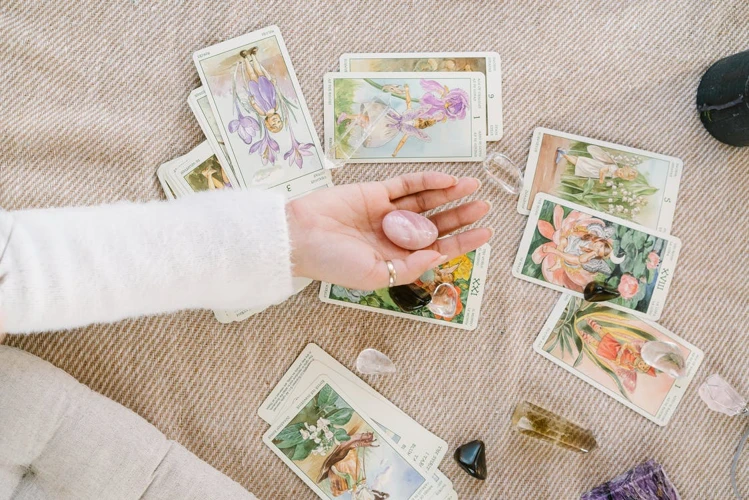
When it comes to developing intuition through meditation, there are several specific techniques that can be highly effective. One powerful technique is breath awareness, where you focus your attention on the breath, observing its natural rhythm and sensations. This practice helps calm the mind and cultivate present-moment awareness, which is essential for accessing intuitive insights. Another technique is visualization, where you create vivid mental images that align with your intentions and desires. By visualizing your intuitive guidance, you can strengthen your connection to the subconscious mind and tap into deeper levels of wisdom. The body scan technique involves directing your attention to different parts of the body, observing and releasing any tension or discomfort. This practice enhances body awareness and helps you attune to the subtle signals and sensations that can inform your intuitive decision-making. These are just a few examples of the specific meditation techniques that can support the development of intuition. Each individual may resonate with different techniques, so it’s important to explore and experiment to find what works best for you.
1. Breath Awareness
Breath awareness is a foundational meditation technique that can greatly assist in developing intuition. This practice involves bringing our attention to the rhythm and sensation of our breath. By focusing on our breath, we anchor ourselves in the present moment, quieting the mind and creating inner stillness. To begin, find a comfortable position and close your eyes. Take a few moments to observe the natural flow of your breath, without trying to control it. Notice the sensation of the breath entering and leaving your body. You may choose to place your hand on your abdomen to feel the rise and fall with each breath. As thoughts arise, gently bring your attention back to your breath. This practice not only cultivates mindfulness and deepens self-awareness, but it also helps to quiet the chatter of the mind, allowing our intuitive wisdom to emerge. As you continue with breath awareness meditation, you may start to notice subtle shifts in your perception and a greater connection to your intuition. It is a simple yet powerful practice that can be easily incorporated into your daily routine.
2. Visualization
Visualization is a powerful technique that can greatly enhance our intuitive abilities. It involves creating vivid mental images or scenes in our minds, allowing us to tap into the power of our imagination. When practicing visualization for intuition development, we can start by finding a quiet and comfortable space where we won’t be interrupted. We can close our eyes and take a few deep breaths to relax our body and mind. As we enter a relaxed state, we can begin to visualize specific scenarios or situations. For example, if we are seeking guidance on a particular decision, we can visualize ourselves in different outcomes and observe our emotional response. Paying attention to any gut feelings, sensations, or insights that arise during the visualization process can provide valuable information and guidance. Visualizations can range from simple scenes to complex narratives that allow us to explore different perspectives and possibilities. Through regular practice, visualization can become a potent tool for accessing our subconscious mind and connecting with our intuition on a deeper level. It is important to remember that each person’s visualization experience may vary, so it’s essential to trust our own unique intuitive insights and interpretations.
3. Body Scan
A body scan is a meditation technique that involves focusing your attention on different parts of your body, from head to toe, and observing any sensations or tension present in each area. The purpose of a body scan is to cultivate a deep sense of awareness and connection with your physical body. By bringing attention to each part, you can release any tension or stress that may be held in those areas.
To practice a body scan meditation, find a comfortable position either sitting or lying down. Close your eyes and bring your attention to your breath, allowing it to become slow and deep. Start by directing your focus to the top of your head. Notice any sensations or feelings in this area without judgment. Move your attention slowly down to your forehead, eyebrows, eyes, and all the way to your toes. Take your time with each body part, noticing any areas of tension or discomfort. As you become aware of these sensations, imagine sending a wave of relaxation and release to those areas.
Continue scanning your body, moving from one part to the next, until you reach the bottom of your feet. Take a few moments to observe the sensations in your entire body as a whole. This practice can help you develop a profound sense of connection and grounding within your physical form. It also allows you to become more attuned to the subtle messages and signals that your body may be sending you.
Remember, the key to a successful body scan meditation is to approach it with a sense of curiosity and non-judgment. Be open to whatever sensations arise and simply observe them without trying to change or analyze them. With regular practice, the body scan meditation can enhance your ability to listen to the wisdom and signals that your body provides, ultimately deepening your intuition and self-awareness.
Other Practices to Enhance Intuition
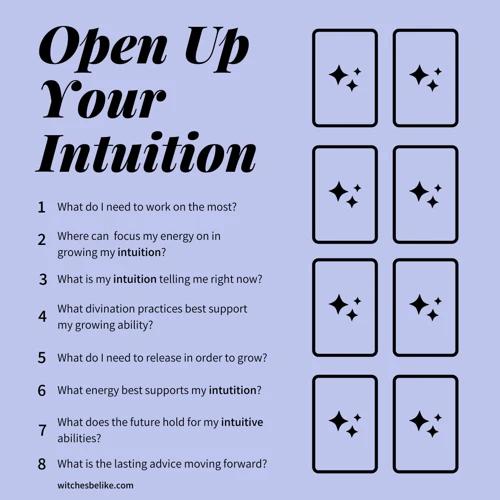
In addition to meditation, there are other practices that can further enhance and develop our intuition. One powerful practice is journaling, which involves writing down thoughts, feelings, and experiences in a reflective manner. Journaling allows us to access and process our subconscious thoughts and emotions, uncovering insights and patterns that can enhance our intuitive abilities. Another practice is tarot meditation, which involves using tarot cards as a focal point during meditation. By connecting with the imagery and symbolism of the cards, we can tap into our intuition and receive messages and guidance. Additionally, mindful tarot reading can help to develop our intuitive skills by actively engaging with the cards, interpreting their meanings, and trusting our intuition to guide us. These practices provide valuable tools for self-reflection, introspection, and intuition development, allowing us to harness the power of our intuition in transformative ways.
1. Journaling
Journaling is a powerful practice for enhancing intuition. It involves writing down our thoughts, feelings, and experiences on a regular basis. Through the act of journaling, we create a space for self-reflection and introspection, allowing us to tap into our subconscious mind and access our intuitive wisdom. When we write in our journal, we can explore our emotions, desires, and beliefs, which can provide valuable insights into our inner world. Journaling also helps us to identify patterns and recurring themes in our lives, which can help us gain clarity and understanding. It is important to approach journaling with an open and non-judgmental mindset, allowing our thoughts and feelings to flow freely onto the page. By regularly journaling and reflecting on our experiences, we can develop a deeper connection with our intuition and gain a greater understanding of ourselves and the world around us. If you want to learn more about how journaling can enhance intuition, you can read our article on /enhancing-intuition-journaling-reflective-writing/.
2. Tarot Meditation
Tarot meditation is a powerful technique that combines the practice of meditation with the symbolic imagery of tarot cards. It allows us to delve deeper into the meanings and messages of the cards, as well as connect with our intuition on a profound level. To begin a tarot meditation, start by selecting a tarot card that you feel drawn to or one that represents a specific question or area of focus for your meditation. Take a few moments to study the card, observing the details, colors, and symbols depicted. Next, find a comfortable seated position, close your eyes, and take a few deep breaths to center yourself. Visualize the tarot card in your mind’s eye. See yourself entering the card, immersing yourself in its energy and symbolism. Allow yourself to explore the card and engage with its elements. Notice any sensations, emotions, or insights that arise as you connect with the card’s energy. Pay attention to any intuitive messages or guidance that comes through during the meditation. You can also journal about your experiences after the meditation to further reflect on the insights gained. Tarot meditation can be a transformative practice that deepens your understanding of the cards and strengthens your intuitive connection with the tarot deck. Incorporating this technique into your meditation practice can enhance your ability to tap into your intuition and access profound wisdom.
3. Mindful Tarot Reading
Mindful tarot reading is a practice that combines the art of tarot interpretation with the principles of mindfulness. It involves approaching each tarot reading session with a present and non-judgmental awareness of the cards, the self, and the surrounding environment. The objective of mindful tarot reading is to cultivate a deep connection with the cards and the intuitive messages they convey. By practicing mindfulness during tarot readings, we become more attuned to our inner thoughts, emotions, and sensations, allowing us to interpret the cards with greater clarity and insight.
To engage in mindful tarot reading, start by creating a calm and sacred space for your reading. This can be a quiet corner of your home, adorned with items that inspire tranquility and focus. Sit in a comfortable position, take a few deep breaths, and ground yourself in the present moment.
Once you have set the intention for your tarot reading, hold the cards in your hands, and take a moment to observe them. Notice the artwork, colors, and symbols on each card. Allow your intuition to guide you as you shuffle the deck, creating a connection between yourself and the cards.
As you lay out the cards in a spread, pay attention to your thoughts, sensations, and emotions that arise. Practice non-judgmental awareness of these experiences, allowing them to come and go without attachment or interpretation. Keep your focus on the present moment and the messages that the cards are communicating to you.
Instead of rushing through the interpretation, take your time with each card. Observe the details, the energy it evokes, and the intuitive insights it sparks within you. Notice any thoughts, feelings, or physical sensations that arise as you explore each card’s meaning.
Throughout the mindful tarot reading, remain connected to your breath and the sensations in your body. This grounding technique helps anchor your awareness in the present moment, preventing the mind from wandering or getting caught up in unnecessary distractions.
By practicing mindful tarot reading, you cultivate a deeper level of awareness and presence. This allows for a more intuitive and profound interpretation of the cards, providing you with guidance and insight into the questions or situations at hand. Remember to approach each reading with an open mind, allowing the messages of the cards to unfold naturally and authentically.
Incorporating mindfulness into your tarot practice can enhance your intuitive abilities and deepen your connection to the cards. It enables you to tap into your inner wisdom and intuition, fostering a more meaningful and insightful tarot reading experience. So, approach your next tarot reading with mindfulness, and discover the transformative power it holds.
Incorporating Meditation into Tarot Reading

Incorporating meditation into tarot reading can significantly enhance the intuitive experience and deepen the connection with the cards. Before starting a tarot reading session, it is beneficial to take a few moments to center oneself through meditation. This allows you to quiet the mind, release any distractions, and create a calm and focused state of being. Begin by finding a quiet and comfortable space where you can sit undisturbed. Close your eyes and take a few deep breaths, allowing your body to relax and your mind to settle. As you enter a meditative state, visualize a serene and sacred space in your mind’s eye. You can imagine a peaceful garden, a tranquil beach, or any other environment that brings you a sense of calm and tranquility. Once you feel centered and present, open your eyes and begin your tarot reading. As you draw and interpret each card, allow yourself to tune into your intuition and listen to any insights or messages that arise. Notice any intuitive sensations in your body, such as a fluttering in the stomach or a tingling sensation in the palms of your hands. Trust your instincts and let your intuition guide you in interpreting the cards and offering meaningful guidance to yourself or others. Remember to take breaks and return to meditation if you feel overwhelmed or need to recenter yourself during the reading. By incorporating meditation into tarot reading, you can create a sacred and intuitive space that allows for deep insight, clarity, and connection with the cards.
Troubleshooting Common Challenges
When incorporating meditation into our daily routine for intuition development, we may encounter common challenges; however, with awareness and practice, we can overcome them. Restlessness and distraction is a common hurdle that arises during meditation. To address this, it is helpful to create a peaceful environment, eliminating external distractions, and utilizing techniques like breath awareness or body scan to bring our focus back to the present moment. Impatience and expectations can also hinder our progress. It is important to cultivate patience and let go of any preconceived notions about how quickly our intuition will develop. Consistency is key in meditation practice, and in order to overcome the challenge of lack of consistency, it can be beneficial to establish a regular meditation schedule and find accountability measures, such as joining a meditation group or using a meditation app, to stay on track. By addressing these challenges head-on, we can ensure that our meditation practice continues to strengthen our intuition and provide the desired results.
1. Restlessness and Distraction
Restlessness and distraction are common challenges that can arise during meditation practice, especially when striving to develop intuition. Restlessness refers to a state of being unable to sit still or focus, while distraction involves the mind wandering and being unable to maintain concentration. These challenges can hinder the development of intuition, as they prevent us from attuning to our inner wisdom. To address restlessness and distraction, it is important to first acknowledge and accept these experiences without judgment. Recognize that these are normal aspects of the mind and meditation practice. One technique to overcome restlessness is to bring awareness to the body and notice any physical sensations that arise. Grounding techniques, such as focusing on the breath or sensations in the feet, can also help in redirecting attention and calming the mind. Additionally, creating a quiet and peaceful environment, minimizing external distractions, and starting with shorter meditation sessions can also assist in overcoming restlessness and cultivating a focused mindset. It is important to remember that these challenges are part of the learning process and with consistent practice, they can be overcome. By developing patience and perseverance, one can pave the way for a more focused and intuitive meditation experience.
2. Impatience and Expectations
Impatience and expectations can pose significant challenges when it comes to meditation for intuition development. Oftentimes, individuals expect immediate results and become impatient when progress does not happen as quickly as anticipated. It’s essential to understand that developing intuition is a gradual process that requires patience and perseverance. Impatience can create unnecessary stress and hinder our ability to enter a meditative state where intuition can flourish. Similarly, having overly high expectations can set us up for disappointment and frustration. When we have specific outcomes in mind, we may overlook the subtle insights and messages that intuition provides. To overcome impatience and manage expectations, it is crucial to approach meditation with a sense of openness and curiosity, rather than a strict agenda. By cultivating a non-judgmental attitude, we allow intuition to unfold in its own time and in ways that may be unexpected. Embracing the present moment and letting go of preconceived notions allows us to fully experience and appreciate the journey of developing our intuition.
3. Lack of Consistency
Lack of consistency can be a common challenge when it comes to meditation for developing intuition. The key to overcoming this challenge is to establish a regular meditation practice. Consistency is crucial because it allows your mind and body to become accustomed to the meditative state and the process of connecting with your intuition. Here are a few strategies to help you maintain consistency in your meditation practice:
1. Set a schedule: Dedicate specific times each day for your meditation practice. This could be in the morning, during lunch break, or in the evening. Setting a schedule will help you prioritize your practice and make it a non-negotiable part of your daily routine.
2. Start with small increments: If sitting for long periods feels overwhelming, start with shorter meditation sessions. Begin with just 5 or 10 minutes and gradually increase the duration over time. This approach makes it more manageable and helps you build the habit of consistency.
3. Create a dedicated space: Designate a peaceful and quiet space in your home where you can meditate. This can be a specific room, a corner with a cushion or chair, or even a spot outside in nature. Having a dedicated space helps set the intention for your practice and makes it easier to remain consistent.
4. Find an accountability partner: Partnering with someone who shares similar goals can greatly enhance your consistency. You can commit to meditating together or simply check in with each other regularly to stay motivated and accountable.
Remember that consistency is more important than the length of your meditation sessions. Even if you can only spare a few minutes a day, it is better to practice consistently rather than sporadically for longer periods. Over time, your consistency will gradually strengthen your intuitive abilities and deepen your connection with your inner wisdom. So, stay committed and be patient with yourself as you cultivate a consistent meditation practice.
Conclusion
In conclusion, meditation is a powerful tool for developing intuition. By deepening self-awareness, enhancing intuitive abilities, and improving focus and concentration, meditation creates the ideal conditions for intuitive insights to arise. It helps us tap into our inner wisdom, connect with our subconscious mind, and access a deeper level of knowing. Incorporating meditation into our daily routine allows us to harness the power of intuition and make more informed decisions in our lives. Additionally, practicing specific meditation techniques such as breath awareness, visualization, and body scan further heightens our intuitive senses. Other complementary practices like journaling, tarot meditation, and mindful tarot reading can also enhance our intuition by fostering self-reflection and introspection. It is important to remember that developing intuition takes time and consistency. With patience and dedication, meditation can become a powerful tool for unlocking our intuitive potential and leading us towards a more meaningful and fulfilling life.
Frequently Asked Questions
1. Can anyone develop their intuition through meditation?
Yes, anyone can develop their intuition through meditation. It is a practice that is accessible to everyone, regardless of their background or level of experience. With consistent effort and dedication, anyone can strengthen their intuitive abilities.
2. How long does it take to see results in intuition development through meditation?
The timeframe for seeing results in intuition development through meditation can vary from person to person. Some individuals may start noticing subtle shifts in their intuitive abilities within a few weeks, while others may take longer. Consistency and regular practice are key factors in accelerating the process.
3. Can meditation help with making better decisions?
Yes, meditation can help with making better decisions. By quieting the mind and creating a state of inner stillness, meditation allows us to tap into our intuition and access deeper insights and wisdom. This can greatly assist in making more informed and aligned decisions.
4. Is it necessary to have prior experience with meditation to develop intuition?
No, prior experience with meditation is not necessary to develop intuition. While some familiarity with meditation techniques can be helpful, beginners can start practicing meditation specifically for intuition development and still experience significant progress.
5. Can meditation help me trust my intuition more?
Yes, meditation can help you trust your intuition more. As you cultivate a regular meditation practice, you will develop a stronger connection to your inner wisdom and intuition. This increased awareness and alignment will naturally enhance your trust in your intuitive guidance.
6. Are there any specific meditation techniques that are more effective for intuition development?
While different techniques work for different individuals, certain meditation techniques can be particularly beneficial for intuition development. Techniques such as breath awareness, visualization, and body scan can help enhance the intuitive senses and deepen the connection to your intuition.
7. Can journaling support intuition development alongside meditation?
Yes, journaling can support intuition development alongside meditation. By reflecting on your meditation experiences, insights, and intuitive sensations, you can gain deeper clarity and understanding of your intuitive abilities. /enhancing-intuition-journaling-reflective-writing/
8. Is tarot meditation an effective practice for honing intuition?
Yes, tarot meditation can be a powerful practice for honing intuition. By utilizing tarot cards as a focal point during meditation, you can cultivate a deeper connection to your intuitive senses and receive insights and guidance from the cards.
9. Can mindfulness during tarot reading enhance intuition?
Yes, incorporating mindfulness during tarot reading can greatly enhance intuition. By being fully present in the moment, paying attention to the sensation of the cards, and listening to your intuitive guidance, you can deepen your connection to your intuition and receive clearer insights during readings.
10. Can meditation help overcome blocks and challenges in intuition development?
Yes, meditation can help overcome blocks and challenges in intuition development. Through the practice of meditation, you can cultivate a sense of inner calmness and clarity, which can help dissolve any resistance or blockages that may hinder the development of your intuition.
